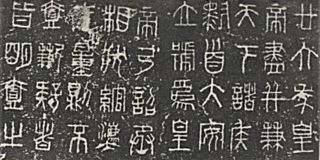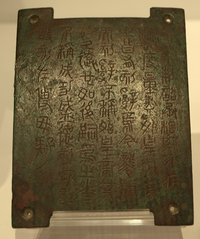
Seal script
Encyclopedia

Zhou Dynasty
The Zhou Dynasty was a Chinese dynasty that followed the Shang Dynasty and preceded the Qin Dynasty. Although the Zhou Dynasty lasted longer than any other dynasty in Chinese history, the actual political and military control of China by the Ji family lasted only until 771 BC, a period known as...
script (see bronze script), arising in the Warring State of Qin
Qin (state)
The State of Qin was a Chinese feudal state that existed during the Spring and Autumn and Warring States Periods of Chinese history...
. The Qin variant of seal script became the standard and was adopted as the formal script for all of China in the Qin dynasty
Qin Dynasty
The Qin Dynasty was the first imperial dynasty of China, lasting from 221 to 207 BC. The Qin state derived its name from its heartland of Qin, in modern-day Shaanxi. The strength of the Qin state was greatly increased by the legalist reforms of Shang Yang in the 4th century BC, during the Warring...
, and was still widely used for decorative engraving and seal
Seal (Chinese)
A seal, in an East Asian context, is a general name for printing stamps and impressions thereof that are used in lieu of signatures in personal documents, office paperwork, contracts, art, or any item requiring acknowledgment or authorship...
s (name chops, or signets) in the Han dynasty
Han Dynasty
The Han Dynasty was the second imperial dynasty of China, preceded by the Qin Dynasty and succeeded by the Three Kingdoms . It was founded by the rebel leader Liu Bang, known posthumously as Emperor Gaozu of Han. It was briefly interrupted by the Xin Dynasty of the former regent Wang Mang...
. Ever since, its predominant use has been in seals, hence the English name. The literal translation of its Chinese name 篆书 (zhuànshū) is decorative engraving script, because by the time this name was coined in the Han dynasty, its role had been reduced to decorative inscriptions rather than as the main script of the day.
See East Asian Calligraphy for examples of seal script compared with modern Chinese script.
Most people today cannot read seal script, so it is generally not used outside the fields of seals
Sigillography
Sigillography is one of the auxiliary sciences of history. It refers to the study of seals attached to documents as a source of historical information. It concentrates on the legal and social meaning of seals, as well as the evolution of their design...
and calligraphy.
Large seal scripts
There are two uses of the word seal script, the Large or Great Seal scriptLarge Seal Script
Large Seal script or Great Seal script is a traditional reference to Chinese writing from before the Qin dynasty, and is now popularly understood to refer narrowly to the writing of the Western and early Eastern Zhou dynasties, and more broadly to also include the oracle bone script...
(大篆 Dàzhuàn; Japanese daiten), and the lesser or Small Seal Script
Xiaozhuan
Lesser Seal Script, or Small Seal Script , or Hsiao-chuan, is an archaic form of Chinese calligraphy. It was standardized by Li Si, prime minister under the First Emperor of China, Qin Shi Huangdi, and promulgated for use during the first imperial dynasty of China, the Qin DynastyBefore the Qin...
(小篆 Xiǎozhuàn; Japanese shōten); the latter is also called simply seal script. The Large Seal script was originally a later, vague Han dynasty reference to writing of the Qin system similar to but earlier than Small Seal. It has also been used to refer to Western Zhou forms or even oracle bones as well. Since the term is an imprecise one, not clearly referring to any specific historical script and not used with any consensus in meaning, modern scholars tend to avoid it, and when referring to seal script, generally mean the (small) seal script of the Qin system, that is, the lineage which evolved in the state of Qin during the Spring and Autumn to Warring States periods and which was standardized under the First Emperor.
Evolution of seal script
There were several different variants of seal script which developed in each kingdom independently during the warring state period and spring and autumn. The "birds and worms" scriptBird-worm seal script
Bird-worm seal script , is a type of ancient seal script originated from China.-Names:...
was used in the Kingdoms of Wu, Chu, and Yue. It was found on several artifacts including the Spear of Fuchai
Spear of Fuchai
The Spear of Fuchai is purportedly the spear of King Fuchai of Wu, the arch-rival of King Goujian of Yue. It was unearthed in Jiangling, Hubei in November 1983. The script on it is a kind of script used only in the states of Wu, Yue, and Chu called 鸟虫文 or bird and worms script, a variant of seal...
, and Sword of Goujian.
On one side of the blade of Goujian, eight characters (in two columns) were written in an ancient script
East Asian calligraphy
East Asian calligraphy is a form of calligraphy widely practised and revered in the Sinosphere. This most often includes China, Japan, Korea, and Vietnam. The East Asian calligraphic tradition originated and developed from China. There is a general standardization of the various styles of...
. The script was found to be the one called 鳥蟲文 "birds and worms characters" (owing to the intricate decorations to the defining strokes), a variant of zhuan that is very difficult to read. Initial analysis of the text deciphered six of the characters, "越王" (King of Yue) and "自作用劍" ("made this sword for (his) personal use").
As a southern state, Chu was close to the Wu-Yue influences. Chu produced broad bronze swords that were similar to Wuyue swords, but not as intricate. Chu also used the Birds and Worms style, which was borrowed by the Wu and Yue states.
Unified small seal script

Li Si
Li Si was the influential Prime Minister of the feudal state and later of the dynasty of Qin, between 246 BC and 208 BC. A famous Legalist, he was also a notable calligrapher. Li Si served under two rulers: Qin Shi Huang, king of Qin and later First Emperor of China—and his son, Qin Er Shi...
李斯 during the reign of the First Emperor of China Qin Shi Huang
Qin Shi Huang
Qin Shi Huang , personal name Ying Zheng , was king of the Chinese State of Qin from 246 BC to 221 BC during the Warring States Period. He became the first emperor of a unified China in 221 BC...
through elimination of most variant structures, and was imposed as the nationwide standard (thus banning other regional scripts), but small seal script was clearly not invented at that time. Through Chinese commentaries, it is known that Li Si compiled Cangjie
Cangjie
Cangjie is a very important figure in ancient China , claimed to be an official historian of the Yellow Emperor and the inventor of Chinese characters. Legend has it that he had four eyes and four pupils, and that when he invented the characters, the deities and ghosts cried and the sky rained...

Clerical script
The clerical script , also formerly chancery script, is an archaic style of Chinese calligraphy which evolved in the Warring States period to the Qin dynasty, was dominant in the Han dynasty, and remained in use through the Wèi-Jìn periods...
隸書, which in turn gave rise to all of the other scripts in use today. However, recent archaeological discoveries and scholarship have led some scholars to conclude that the direct ancestor of clerical script was proto-clerical script, which in turn evolved out of the little-known vulgar or popular writing of the late Warring States to Qin period (see Qiu Xigui, in references).
The first known character dictionary
Dictionary
A dictionary is a collection of words in one or more specific languages, often listed alphabetically, with usage information, definitions, etymologies, phonetics, pronunciations, and other information; or a book of words in one language with their equivalents in another, also known as a lexicon...
was the 3rd century BC Erya
Erya
The Erya is the oldest extant Chinese dictionary or Chinese encyclopedia. Bernhard Karlgren concluded that "the major part of its glosses must reasonably date from" the 3rd century BC....
爾雅, collated and bibliographed by Liu Xiang
Liu Xiang
Liu Xiang is a Chinese 110 meter hurdler. Liu is an Olympic Gold medalist and World Champion. His 2004 Olympic gold medal was the first in a men's track and field event for China....
劉向 and his son Liu Xin
Liu Xin
Liu Xin , later changed name to Liu Xiu , courtesy name Zijun , was a Chinese astronomer, historian, and editor during the Xin Dynasty . He was the son of Confucian scholar Liu Xiang and an associate of other prominent thinkers such as the philosopher Huan Tan...
劉歆, lost the pre-Han script during the course of textual transmission. Not long after however, the Shuowen Jiezi
Shuowen Jiezi
The Shuōwén Jiězì was an early 2nd century CE Chinese dictionary from the Han Dynasty. Although not the first comprehensive Chinese character dictionary , it was still the first to analyze the structure of the characters and to give the rationale behind them , as well as the first to use the...
說文解字 (AD 100–121), the lifework of Xu Shen
Xu Shen
Xǔ Shèn was a Chinese philologist of the Han Dynasty. He was the author of Shuowen Jiezi, the first Chinese dictionary with character analysis, as well as the first to organize the characters by shared components. It contains over 9,000 character entries under 540 radicals, explaining the origins...
許愼 Han Dynasty
Han Dynasty
The Han Dynasty was the second imperial dynasty of China, preceded by the Qin Dynasty and succeeded by the Three Kingdoms . It was founded by the rebel leader Liu Bang, known posthumously as Emperor Gaozu of Han. It was briefly interrupted by the Xin Dynasty of the former regent Wang Mang...
, was written. Its 9,353 entries reproduce the standardized small-seal script variant for each entry, and for some entries other pre-Han variants from the late Zhou era. Entries are categorized under 540 section headers
Radical (Chinese character)
A Chinese radical is a component of a Chinese character. The term may variously refer to the original semantic element of a character, or to any semantic element, or, loosely, to any element whatever its origin or purpose...
.

